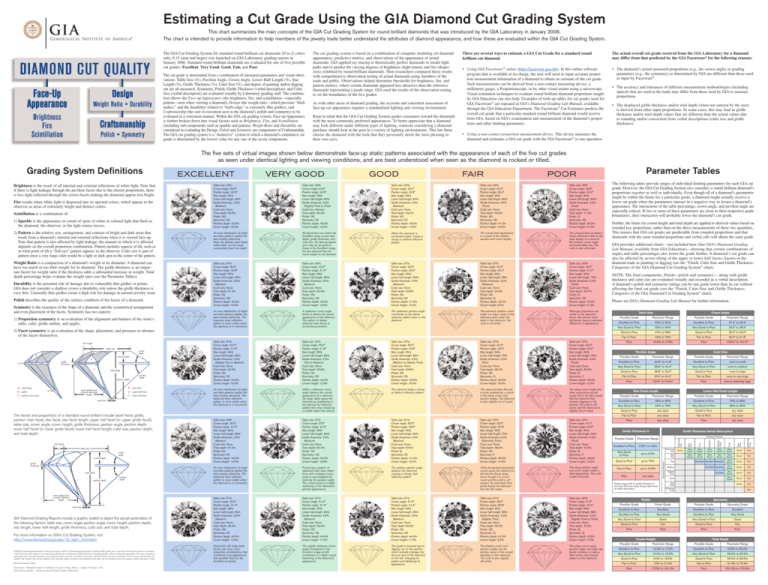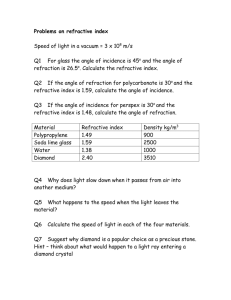
Estimating a Cut Grade Using the GIA Diamond Cut Grading System
This chart summarizes the main concepts of the GIA Cut Grading System for round brilliant diamonds that was introduced by the GIA Laboratory in January 2006.
The chart is intended to provide information to help members of the jewelry trade better understand the attributes of diamond appearance, and how these are evaluated within the GIA Cut Grading System.
The GIA Cut Grading System for standard round brilliant cut diamonds (D to Z colors
only, 0.15 carat and larger) was launched on GIA Laboratory grading reports in
January 2006. Standard round brilliant diamonds are evaluated for one of five possible
cut grades: Excellent, Very Good, Good, Fair, and Poor.
The cut grade is determined from a combination of measured parameters and visual observations. Table Size (%), Pavilion Angle, Crown Angle, Lower Half Length (%), Star
Length (%), Girdle Thickness (%), Culet Size (%), and degree of painting and/or digging
out are all measured. Symmetry, Polish, Girdle Thickness (verbal description), and Culet
Size (verbal description) are evaluated visually by Laboratory grading staff. The combination allows the Face-up Appearance (the brightness, fire, and scintillation—especially
pattern—seen when viewing a diamond), Design (the weight ratio—which prevents “thick
makes,” and the durability–related to “knife-edge” or extremely thin girdles), and
Craftsmanship (the care in execution seen in the diamond’s polish and symmetry) to be
evaluated in a consistent manner. Within the GIA cut grading system, Face-up Appearance
is further broken down into visual factors such as Brightness, Fire, and Scintillation
(including sub-components such as sparkle and pattern). Weight Ratio and Durability are
considered in evaluating the Design. Polish and Symmetry are components of Craftsmanship.
The GIA cut grading system is a “deductive” system in which a diamond’s cumulative cut
grade is determined by the lowest value for any one of the seven components.
The cut grading system is based on a combination of computer modeling (of diamond
appearance), predictive metrics, and observations of the appearance of actual
diamonds. GIA applied ray-tracing to theoretically perfect diamonds to model light
paths and to predict the varying degrees of brightness (light return) and fire (dispersion) exhibited by round brilliant diamonds. Then researchers compared those results
with comprehensive observation testing of actual diamonds using members of the
trade and public. Observations helped determine thresholds for brightness, fire, and
pattern metrics, where certain diamonds appeared less attractive than the reference
diamonds representing a grade range. GIA used the results of the observation testing
to set the boundaries of the five grades.
As with other areas of diamond grading, the accurate and consistent assessment of
face-up cut appearance requires a standardized lighting and viewing environment.
Keep in mind that the GIA Cut Grading System guides consumers toward the diamonds
with the most commonly preferred appearances. To better appreciate that a diamond
may look different under different types of lighting, someone considering a diamond
purchase should look at the gem in a variety of lighting environments. This lets them
choose the diamond with the look that they personally deem the most pleasing to
their own eyes.
There are several ways to estimate a GIA Cut Grade for a standard round
brilliant cut diamond.
The actual overall cut grade received from the GIA Laboratory for a diamond
may differ from that predicted by the GIA Facetware® for the following reasons:
• Using GIA Facetware ® online (http://facetware.gia.edu). In this online software
program that is available at no charge, the user will need to input accurate proportion measurement information of a diamond to obtain an estimate of the cut grade.
Such measurements can be derived from a non-contact measuring device, a
millimeter gauge, a Proportionscope, or by other visual means using a microscope.
Visual estimation techniques to evaluate round brilliant diamond proportions taught
by GIA Education can also help. Examples of look-up tables for cut grades used for
GIA Facetware® are repeated in GIA’s Diamond Grading Lab Manual, available
through the GIA Education Department. The Facetware® Cut Estimator predicts the
overall cut grade that a particular standard round brilliant diamond would receive
from GIA, based on GIA’s examination and measurement of the diamond’s proportions and other limiting parameters.
• The diamond’s actual measured proportions (e.g., the crown angle) or grading
parameters (e.g., the symmetry) as determined by GIA are different than those used
as input by Facetware®.
• The accuracy and tolerances of different measurement methodologies (including
optical) that are used in the trade may differ from those used by GIA to measure
proportions.
• The displayed girdle thickness and/or total depth (when not entered by the user)
is derived from other input proportions. In some cases, this may lead to girdle
thickness and/or total depth values that are different than the actual values due
to rounding and/or conversion from verbal descriptions (culet size and girdle
thickness).
• Using a non-contact proportion measurement device. This device measures the
diamond and estimates a GIA cut grade with the GIA Facetware® in one operation.
The five sets of virtual images shown below demonstrate face-up static patterns associated with the appearance of each of the five cut grades
as seen under identical lighting and viewing conditions, and are best understood when seen as the diamond is rocked or tilted.
Symmetry is the exactness of the shape of a diamond, and the symmetrical arrangement
and even placement of the facets. Symmetry has two aspects:
1) Proportion symmetry is an evaluation of the alignment and balance of the stone’s
table, culet, girdle outline, and angles.
Table size: 53%
Crown angle: 30.0°
Pavilion angle: 39.4°
Star length: 55%
Lower half length: 80%
Girdle thickness: 5.5%
(Thick)
Culet size: None
Total depth: 59.8%
Polish: VG
Symmetry: VG
Pavilion depth: 41.0%
Crown height: 13.5%
Table size: 48%
Crown angle: 39.0°
Pavilion angle: 42.0°
Star length: 55%
Lower half length: 80%
Girdle thickness: 5.5%
(Thick)
Culet size: None
Total depth: 71.3%
Polish: G
Symmetry: VG
Pavilion depth: 45.0%
Crown height: 21.0%
An even distribution of bright
and dark patterns typifies the
best looking diamonds.
Here, the pavilion main facets
reflect dark, but the areas
surrounding them are bright.
All parameters are within the
Excellent range except total
depth, girdle thickness, and
culet size. The face-up appearance may be as good as
those in the Excellent range,
but the diamond has too
much weight for its diameter.
While this diamond is
somewhat bright, it lacks a
strong or distinct reflection
pattern.
The overall dark appearance
is a result of the shallow
pavilion and crown angles.
The unusual face-up pattern
(culet reflections seen in the
main facets) is a result of
the extreme crown angle
and small table size. The
culet is also off-center.
Table size: 57%
Crown angle: 35.5°
Pavilion angle: 40.8°
Star length: 55%
Lower half length: 80%
Girdle thickness: 3.0%
(Medium)
Culet size: None
Total depth: 61.2%
Polish: EX
Symmetry: VG
Pavilion depth: 43.0%
Crown height: 15.5%
Table size: 53%
Crown angle: 30.0°
Pavilion angle: 41.4°
Star length: 55%
Lower half length: 80%
Girdle thickness: 3.5%
(Medium)
Culet size: None
Total depth: 60.9%
Polish: VG
Symmetry: VG
Pavilion depth: 44.0%
Crown height: 13.5%
Table size: 57%
Crown angle: 33.5°
Pavilion angle: 39.6°
Star length: 55%
Lower half length: 80%
Girdle thickness: 3.0%
(Medium)
Culet size: None
Total depth: 58.8%
Polish: VG
Symmetry: EX
Pavilion depth: 41.5%
Crown height: 14.0%
Table size: 57%
Crown angle: 24.0°
Pavilion angle: 40.2°
Star length: 55%
Lower half length: 85%
Girdle thickness: 3.0%
(Medium)
Culet size: None
Total depth: 54.8%
Polish: VG
Symmetry: G
Pavilion depth: 42.0%
Crown height: 9.5%
Table size: 50%
Crown angle: 40.0°
Pavilion angle: 41.0°
Star length: 55%
Lower half length: 70%
Girdle thickness: 5.5%
(Thick)
Culet size: None
Total depth: 69.7%
Polish: G
Symmetry: VG
Pavilion depth: 43.5%
Crown height: 21.0%
An even distribution of bright
and dark patterns typifies the
best looking diamonds. The
balanced even reflection
pattern is more visible when
the diamond is in movement.
A shallower crown angle
tends to darken the overall
appearance of the diamond.
The pattern of darker
reflected main facets is
somewhat prominent.
The shallower pavilion angle
contributes to the darker
reflection pattern seen in this
diamond.
The extremely shallow crown
angle is a major cause of the
darkness seen under the
table in this diamond. The
culet is off-center.
Although proportions are
similar to the diamond
above, the shorter lower
half facets cause a dramatic
difference in appearance.
2) Facet symmetry is an evaluation of the shape, placement, and presence or absence
of the facets themselves.
star length
table size
crown
angle
d
a
crown height
e
girdle
thickness
b
f
total depth
pavilion depth
a — bezel facet
b — girdle
c — pavilion main facet
d — star facet
e — upper half facet
f — lower half facet
lower girdle facet
or lower half facet
length
c
pavilion
angle
culet size
The facets and proportions of a standard round brilliant include bezel facet, girdle,
pavilion main facet, star facet, star facet length, upper half facet (or upper girdle facet),
table size, crown angle, crown height, girdle thickness, pavilion angle, pavilion depth,
lower half facet (or lower girdle facet), lower half facet length, culet size, pavilion depth,
and total depth.
star length
table size
crown
angle
crown height
girdle
thickness
total depth
pavilion depth
pavilion
angle
lower girdle facet
or lower half facet
length
culet size
GIA Diamond Grading Reports include a graphic scaled to depict the actual parameters of
the following factors: table size, crown angle, pavilion angle, crown height, pavilion depth,
star length, lower half length, girdle thickness, culet size, and total depth.
For more information on GIA’s Cut Grading System, visit
http://www.diamondcut.gia.edu/10_learn_more.html
©2009 The Gemological Institute of America. All rights reserved. The Gemological Institute of America (GIA) grants you a one-time, non-exclusive license to reproduce
in print form this chart solely for non-commercial, private use to reference the GIA Diamond Cut Grading System within an individual organization. This chart may also be
reproduced and used electronically in circumstances where such use is limited to the private, internal business use by the individual or firm to whom GIA provides the
material. The material may not be modified in any way. GIA retains all rights to the material, and all other use is prohibited without the express, written permission of GIA.
Revised December 2009
Contributors: T. Blodgett, R. Geurts, A. Gilbertson, A. Lucas, D. Pay, I. Reinitz, J. Shigley, K. Yantzer, C. Zink
Editor: Brooke Goedert Design and layout: Richard Canedo, Al Gilbertson
Table size: 57%
Crown angle: 32.0°
Pavilion angle: 41.6°
Star length: 55%
Lower half length: 80%
Girdle thickness: 2.5%
(Slightly Thin to Medium)
Culet size: None
Total depth: 60.5%
Polish: VG
Symmetry: EX
Pavilion depth: 44.5%
Crown height: 13.5%
Table size: 57%
Crown angle: 29.0°
Pavilion angle: 41.8°
Star length: 55%
Lower half length: 80%
Girdle thickness: 2.5%
(Thin to Medium)
Culet size: None
Total depth: 59.8%
Polish: VG
Symmetry: EX
Pavilion depth: 44.5%
Crown height: 12.0%
Table size: 57%
Crown angle: 33.5°
Pavilion angle: 42.8°
Star length: 55%
Lower half length: 80%
Girdle thickness: 3.5%
(Medium to Slightly Thick)
Culet size: None
Total depth: 63.8%
Polish: VG
Symmetry: EX
Pavilion depth: 46.5%
Crown height: 14.0%
Table size: 57%
Crown angle: 40.0°
Pavilion angle: 43.0°
Star length: 50%
Lower half length: 70%
Girdle thickness: 2.5%
(Thin)
Culet size: None
Total depth: 68.2%
Polish: VG
Symmetry: G
Pavilion depth: 46.5%
Crown height: 18.0%
Table size: 57%
Crown angle: 40.0°
Pavilion angle: 43.0°
Star length: 55%
Lower half length: 75%
Girdle thickness: 5.5%
(Thick)
Culet size: None
Total depth: 69.8%
Polish: G
Symmetry: F
Pavilion depth: 46.5%
Crown height: 12.5%
An even distribution of bright
and dark patterns typifies the
best looking diamonds. The
balanced even reflection
pattern is more visible when
the diamond is in movement.
While a shallower crown
angle darkens the overall
appearance of a diamond,
the larger table opens the
diamond up, brightening it,
but altering the reflection
pattern from that created by
a smaller table (see above).
This diamond lacks a strong
or distinct reflection pattern.
This diamond lacks life and
is quite unattractive, a result
of the steep crown and
pavilion angles. The diamond
is also slightly out of round.
The steep crown angle and
other proportions would
cause this to be Fair, except
that this diamond has
extreme digging on the
pavilion, the culet is offcenter and the diamond is
slightly out-of-round.
Table size: 59%
Crown angle: 35.0°
Pavilion angle: 41.0°
Star length: 55%
Lower half length: 80%
Girdle thickness: 3.5%
(Medium)
Culet size: None
Total depth: 61.2%
Polish: EX
Symmetry: EX
Pavilion depth: 43.5%
Crown height: 14.5%
Table size: 57%
Crown angle: 37.5°
Pavilion angle: 40.2°
Star length: 55%
Lower half length: 80%
Girdle thickness: 3.5%
(Medium)
Culet size: None
Total depth: 62.2%
Polish: VG
Symmetry: VG
Pavilion depth: 42.0%
Crown height: 16.5%
Table size: 61%
Crown angle: 33.5°
Pavilion angle: 39.6°
Star length: 55%
Lower half length: 80%
Girdle thickness: 3.0%
(Medium)
Culet size: None
Total depth: 57.5%
Polish: G
Symmetry: EX
Pavilion depth: 41.0%
Crown height: 13.0%
Table size: 57%
Crown angle: 33.5°
Pavilion angle: 42.8°
Star length: 55%
Lower half length: 70%
Girdle thickness: 8.0%
(Extremely Thick)
Culet size: None
Total depth: 68.5%
Polish: VG
Symmetry: F
Pavilion depth: 46.5%
Crown height: 14.0%
Table size: 57%
Crown angle: 41.0°
Pavilion angle: 44.0°
Star length: 55%
Lower half length: 80%
Girdle thickness: 5.5%
(Thick)
Culet size: None
Total depth: 72.2%
Polish: G
Symmetry: F
Pavilion depth: 48.5%
Crown height: 12.5%
An even distribution of bright
and dark patterns typifies the
best looking diamonds. The
balanced even reflection
pattern is more visible when
the diamond is in movement.
Producing a pattern of
darkened main facet reflections with a steeper crown
angle is accomplished by
lowering the pavilion angle.
The overall result is a slight
darkening of the diamond’s
general appearance.
The shallow pavilion angle
darkens this diamond,
creating a strong, dark
reflection pattern.
While the general proportions
would cause this diamond to
fall into the Good range
(even though it is out-ofround and the culet is offcenter), the extremely thick
girdle lowers the diamond
into the Fair range.
The steep pavilion angle
and crown angle create a
dark appearance. The culet
is also off-center.
Table size: 61%
Crown angle: 33.0°
Pavilion angle: 41.2°
Star length: 55%
Lower half length: 80%
Girdle thickness: 2.5%
(Medium)
Culet size: None
Total depth: 59.2%
Polish: VG
Symmetry: EX
Pavilion depth: 43.5%
Crown height: 12.5%
Table size: 61%
Crown angle: 31.0°
Pavilion angle: 41.4°
Star length: 55%
Lower half length: 80%
Girdle thickness: 3.5%
(Medium)
Culet size: None
Total depth: 59.0%
Polish: VG
Symmetry: VG
Pavilion depth: 44.0%
Crown height: 11.5%
Table size: 61%
Crown angle: 31.0°
Pavilion angle: 41.4°
Star length: 55%
Lower half length: 80%
Girdle thickness: 3.5%
(Medium)
Culet size: None
Total depth: 60.0%
Polish: VG
Symmetry: VG
Pavilion depth: 44.0%
Crown height: 11.5%
Table size: 61%
Crown angle: 26.0°
Pavilion angle: 39.8°
Star length: 45%
Lower half length: 85%
Girdle thickness: 4.0%
(Slightly Thick)
Culet size: None
Total depth: 55.2%
Polish: VG
Symmetry: G
Pavilion depth: 41.5%
Crown height: 9.5%
Table size: 60%
Crown angle: 41.5°
Pavilion angle: 43.4°
Star length: 65%
Lower half length: 85%
Girdle thickness: 5.0%
(Slightly Thick to Thick)
Culet size: None
Total depth: 70.2%
Polish: G
Symmetry: G
Pavilion depth: 47.5%
Crown height: 17.5%
Diamonds with large table
facets only have a few
proportion combinations that
contribute to an appearance
that qualifies them for the
Excellent cut grade.
The slightly shallower crown
angle (compared to the
Excellent image at left)
contributes to a slight overall
darkening of the diamond’s
appearance.
The grade is lowered due to
digging out on the pavilion
which radically changes the
face-up view of the diamond
on the left, changing its
pattern and darkening its
appearance.
The shallow crown and
pavilion angles are the
primary cause of the overall
darkness in this diamond.
The culet is also slightly
off-center.
The steep crown angle,
pavilion angle, and large star
facets combine to make a
dark center and unusual
pattern in this diamond.
The following tables provide ranges of individual limiting parameters for each GIA cut
grade. However, the GIA Cut Grading System also considers a round brilliant diamond’s
proportions together as well as individually. Even though all of a diamond’s parameters
might be within the limits for a particular grade, a diamond might actually receive a
lower cut grade when the parameters interact in a negative way to lessen a diamond’s
appearance. The interactions of the table percentage, crown angle, and pavilion angle are
especially critical. If two or more of these parameters are close to their respective grade
boundaries, their interaction will probably lower the diamond’s cut grade.
Further, the limits for crown height and total depth are applied to derived values based on
rounded key proportions, rather than on the direct measurements of these two quantities.
This insures that GIA cut grades are predictable from rounded proportions and that
diamonds with the same rounded proportions and verbal calls will obtain the same grade.
GIA provides additional charts—not included here (See GIA’s Diamond Grading
Lab Manual, available from GIA Education)—showing that certain combinations of
angles and table percentages also lower the grade further. A diamond’s cut grade can
also be affected by severe tilting of the upper or lower half facets, known in the
diamond trade as painting or digging (see the “Finish, Culet Size and Girdle Thickness;
Categories of the GIA Diamond Cut Grading System” chart).
NOTE: The final components; Finish—polish and symmetry— along with girdle
thickness and culet size are evaluated visually and recorded as a verbal description.
A diamond’s polish and symmetry ratings can be one grade lower than its cut without
affecting the final cut grade (see the “Finish, Culet Size and Girdle Thickness;
Categories of the GIA Diamond Cut Grading System” chart).
Please see GIA’s Diamond Grading Lab Manual for further information.
Table Size
Crown Angle
Possible Grade
Parameter Range
Possible Grade
Parameter Range
Excellent to Poor
52% to 62%
Excellent to Poor
31.5º to 36.5º
Very Good to Poor
50% to 66%
Very Good to Poor
26.5º to 38.5º
Good to Poor
47% to 69%
Good to Poor
22.0º to 40.0º
Fair to Poor
44% to 72%
Fair to Poor
20.0º to 41.5º
Poor
<44% to >72%
Poor
<20.0º to >41.5º
Pavilion Angle
Culet Size
Possible Grade
Parameter Range
Possible Grade
Parameter Range
Excellent to Poor
40.6º to 41.8º
Excellent to Poor
none to small
Very Good to Poor
39.8º to 42.4º
Very Good to Poor
none to medium
Good to Poor
38.8º to 43.0º
Good to Poor
none to large
Fair to Poor
37.4º to 44.0º
Fair to Poor
none to very large
Poor
<37.4º to >44.0º
Poor
none to extremely large
Star Facet Length
Lower Half Facet Length
Possible Grade
Parameter Range
Possible Grade
Parameter Range
Excellent to Poor
45% to 65%
Excellent to Poor
70% to 85%
Very Good to Poor
40% to 70%
Very Good to Poor
65% to 90%
Good to Poor
any value
Good to Poor
any value
Fair to Poor
any value
Fair to Poor
any value
Poor
any value
Poor
any value
Girdle Thickness %
Girdle Thickness Verbal Description
Possible Grade
Parameter Range
Excellent to Poor
2.5%* to 4.5%
Extremely
Thin
Very Good
to Poor
up to 5.5%
Good to Poor
up to 7.5%
Fair to Poor
up to 10.5%
Poor
Thickest Portion
Very
Thin
any value
Good
Extremely
Thick
Polish describes the quality of the surface condition of the facets of a diamond.
Table size: 53%
Crown angle: 32.0°
Pavilion angle: 42.8°
Star length: 55%
Lower half length: 80%
Girdle thickness: 3.5%
(Medium)
Culet size: None
Total depth: 64.2%
Polish: VG
Symmetry: EX
Pavilion depth: 46.5%
Crown height: 14.5%
Very
Thick
Durability is the potential risk of damage due to vulnerable thin girdles or points.
GIA does not consider a shallow crown a durability risk unless the girdle thickness is
very thin. Unusually thin girdles create a high risk for damage in normal jewelry wear.
Table size: 53%
Crown angle: 34.5°
Pavilion angle: 40.8°
Star length: 55%
Lower half length: 80%
Girdle thickness: 4.5%
(Slightly Thick to Thick)
Culet size: Medium
Total depth: 64.2%
Polish: VG
Symmetry: EX
Pavilion depth: 43.0%
Crown height: 16.0%
Thick
Weight Ratio is a comparison of a diamond's weight to its diameter. A diamond can
have too much or too little weight for its diameter. The girdle thickness is an important factor for weight ratio if the thickness adds a substantial increase in weight. Total
depth percentage helps evaluate the weight ratio (see the Parameter Tables).
Table size: 53%
Crown angle: 34.5°
Pavilion angle: 40.8°
Star length: 55%
Lower half length: 80%
Girdle thickness: 2.5%
(Medium)
Culet size: None
Total depth: 62.5%
Polish: VG
Symmetry: EX
Pavilion depth: 43.0%
Crown height: 16.0%
Slightly
Thick
2) Pattern is the relative size, arrangement, and contrast of bright and dark areas that
result from a diamond’s internal and external reflections when it is viewed face-up.
Note that pattern is also affected by light leakage; the manner in which it is affected
depends on the overall proportion combination. Pattern includes aspects of tilt, such as
at what point of tilt a “fish-eye” pattern appears to the observer. Culet size is part of
pattern since a very large culet would be a light or dark spot in the center of the pattern.
Parameter Tables
POOR
Medium
1) Sparkle is the appearance or extent of spots of white or colored light that flash as
the diamond, the observer, or the light source moves.
FAIR
Thin
Scintillation is a combination of:
GOOD
Very
Thin
Fire results when white light is dispersed into its spectral colors, which appear to the
observer as areas of extremely bright and distinct colors.
VERY GOOD
Extremely
Thin
Brightness is the result of all internal and external reflections of white light. Note that
if there is light leakage through the pavilion facets due to the chosen proportions, there
is less light reflected through the crown facets making the diamond appear less bright.
EXCELLENT
Thinnest Portion
Grading System Definitions
Very
Good
Very
Good
Very
Good
Very
Good
Very
Good
Good
Fair
Very
Good
Very
Good
Very
Good
Very
Good
Very
Good
Good
Fair
Thin
Excellent Excellent Excellent
Very
Good
Good
Fair
Medium
Excellent Excellent
Very
Good
Good
Fair
Slightly
Thick
Excellent
Very
Good
Good
Fair
Very
Good
Good
Fair
Good
Fair
Thick
Very
Thick
*Grade range limits for girdle thickness of
less than 2.5% are nearly always determined
by verbal description.
Extremely
Thick
Fair
Polish
Symmetry
Possible Grade
Polish Grade
Possible Grade
Symmetry Grade
Excellent to Poor
Excellent
Excellent to Poor
Excellent
Excellent to Poor
Very Good
Excellent to Poor
Very Good
Very Good to Poor
Good
Very Good to Poor
Good
Good to Poor
Fair
Good to Poor
Fair
Poor
Poor
Poor
Poor
Crown Height
Total Depth
Possible Grade
Parameter Range
Possible Grade
Parameter Range
Excellent to Poor
12.5% to 17.0%
Excellent to Poor
57.5% to 63.0%
Very Good to Poor
10.5% to 18.0%
Very Good to Poor
56.0% to 64.5%
Good to Poor
9.0% to 19.5%
Good to Poor
53.0% to 66.5%
Fair to Poor
7.0% to 21.0%
Fair to Poor
51.9% to 70.9%
Poor
<7.0% to >21.0%
Poor
<51.9% to >70.9%








